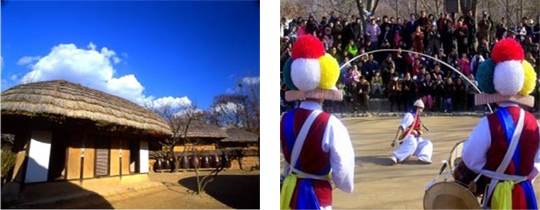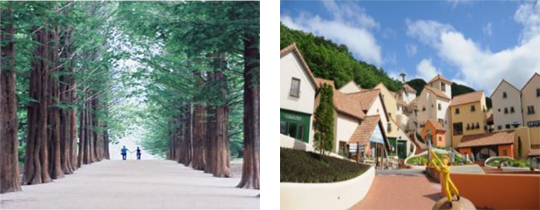
영수증 및 참가확인증은 ksccm.org 학회 홈페이지에서 확인 가능합니다.
회원은 로그인 후 마이페이지에서, 비회원은 행사 - 등록조회에서 확인 가능합니다.
View Receipt & Confirmation of participation is possible on ksccm.org homepage.
For members, allow after login - mypage, for non members can search on conference - registration.
KSCCM 2020 will have exciting tour programs.
There is an additional charge to join the tour programs.

| Tour | T-11 | Time | 13:00 ~ 17:30 |
|---|---|---|---|
| Date | Available everyday | Price | *Morning: 75,000KRW P/P(min.2people) *Afternoon: 60,000KRW P/P(min.2people) |
| Inclusion | Tour guide, transportation and entrance fees. | ||
| Itinerary | Hotel Pick up - Korean Folk Village (Traditional Houses or Farmers Music & Dance or Equestrain Feats) - Ginseng Center - Drop off at Hotel. | ||
| Note | * The Performances inside the Korean Folk Village can be cancelled depends on the weather. | ||
| Information of Tourlist Attraction | Korean Folk Village Set in a natural environment occupying approximately 243 acres, visitors can experience the natural atmosphere with over 260 traditional houses reminiscent of the late Joseon Dynasty, including various household goods from different regions. All these features have been relocated and restored to provide visitors with a broad understanding of Korean food, clothing, and housing style of the past. About twenty workshops, various handicrafts such as pottery, baskets, winnows, bamboo wares, wooden wares, paper, brass wares, knots, fans, musical instruments, iron wares and embroidery are practiced. In the Korean Folk Village, where the customs and lifestyles of the past generations have been carefully preserved, various lifestyles prevalent during the Joseon Dynasty can be seen. You can visit the Folk Museum as well as the Art Museum (scheduled to open) to see and learn about the essence of Korean culture and folk customs, which are not suitable for display and re-creating in the open-air setting. Korean Folk Village is also the filming location for the famous movie Scandal as well as the TV miniseries Daejanggeum |
||

| Tour | T-14 | Time | 09:00 ~ 17:30 |
|---|---|---|---|
| Date | Available everyday | Price | 85,000KRW P/P (min.1person) |
| Inclusion | Tour guide, transportation and entrance fees. | ||
| Itinerary | Hotel Pick up - Jogyesa Buddhist Temple - Changing of the Guard Ceremony - Gyeongbok Palace (Deoksu Palace Tuesday only) Pass by Presidential Blue House - Cheongwadae Sarangchae (closed every Monday) - Ginseng Center - Lunch - Changdeok Palace(N Seoul Tower on Monday only; excluding Observatory) - Insadong Arts and Crafts Market - Namdaemun Traditional Market - Drop off at Hotel | ||
| Note | * Cheongwadae Sarangchae closes on Mondays * Deoksu Palace instead of Gyeongbok Palace on Tuesday. * N Seoul Tower excluding Observatory instead of Changdeok Palace on Monday. * Changing of the Guard Ceremony can be cancelled depends on the weather. * There is 100% Cancellation charge if you cancel on the tour day |
||
| Information of Tourlist Attraction | Jogyesa Buddhist Temple Jogyesa Buddhist Temple is the center of Zen Buddhism in Korea, and is famous for being located in the city. From the busy streets of Jongno, follow the road towards Anguk Subway Station, and you will see Jogyesa Temple. The first things you will notice at the temple are the lovely trees. These locust trees and baeksong trees in front of the Daeungjeon, the main temple building, are about 500 years old. Cheongwadae Sarangchae The newly opened Cheongwadae Sarangchae, which opened to the public on January 5th, 2010, is a history center that gives visitors a chance to follow in the footsteps of presidents of Korea and gain insight into the history of Seoul. It encompasses the past, present and even the future of Seoul as well as the entire nation. It serves as a tourist information center that offers detailed information on World Cultural Heritage sites and assets. Presidential Blue House The symbol of Cheongwadae (known to westerners as the Blue House or the presidential residence), is the blue tiles. The first thing that catches your eye when you arrive at Cheongwadae is the blue tiles of the main building. The blue tiles and the smooth roof are in beautiful harmony with Mt. Bugaksan behind it. As the Blue House represents Korea, the blue tiles and the smooth curve of the roof represents the beauty of Korea. Changing of the Guard Ceremony Everyday visitors to Gyeongbok palace can watch a reenactment of the "Changing of the Royal Guards” ceremony, which takes place at the Gwanghwamun and Heungnyemun plazas. The royal guards of the Joseon Dynasty (1392~1910) were in charge of protecting the gates of the capital city and the royal palace. Gyeongbok Palace Built in 1395, Gyeongbok Palace is also commonly referred to as the “Northern Palace” because it is located more toward the north, compared to the neighboring palaces of Changdeok (Eastern Palace) and Gyeonghee (Western Palace). Gyeongbok Palace is arguably the most beautiful and remains the grandest of all the five palaces. Changdeok Palace Changdeok Palace is the second royal villa built after Gyeongbok Palace in 1405. Changdeok was the principal palace for many of the Joseon kings, and is the best preserved among the five remaining royal Joseon palaces. The rear garden that was used as a place of rest by the kings boasts a gigantic tree that is over 300 years old, a small pond, and a pavilion. The palace grounds are comprised of a public palace area, a royal family residence building, and the rear garden. Insadong Arts & Crafts Market Insadong has been at the heart of nation’s capital for 600 years and it has been the center of culture during the Chosun Dynasty (1392-1910). This is where the Ministry of Art was once situated. Insadong usually refers to the area from Anguk-dong Rotary to Tapgol Park in Jongro 2(i)-ga, past the Insadong Intersection. The notable features of Insadong are the countless alleys that branching out from the main street. Insadong has become known as ‘Merry’s Area,’ a favorite shopping spot among foreigners. Namdaemun Traditional Market Opened in 1964, Namdaemun Market is the first largest traditional market in Korea with various goods in store such as children’s, men’s and women’s wear. The displayed goods are sold at a reasonable price and it also functions as a wholesale market. Most of the goods are produced directly from shopkeepers. Namdaemun Market is opened from 11:00 pm and at 3:00 am; it is crowded with retailers from all over the country. At daybreak, the site of busy Koreans creates a unique scene in the market where it is becoming a worldwide tourist attraction. |
||

| Tour | T-25 (Morning Tour) | Time | 08:00 ~ 13:30 |
|---|---|---|---|
| Date | Available everyday except Monday | Price | * 55,000KRW P/P (min.1person) * 50,000KRW P/P (min.3people) |
| Inclusion | Tour guide, transportation and entrance fees. | ||
| Itinerary | Hotel Pick up - Imjingak Park - The Bridge of Freedom - The 3rd Infiltration Tunnel - DMZ Theater/Exhibition Hall - Dora Observatory - Dorasan Station - Unification Village (Pass by) - Drop off at City Hall or Itaewon | ||
| Note | * DMZ closes every Monday and National Holiday. * Passport is needed on the tour day. * No special dress code for DMZ tour. |
||
| Information of Tourlist Attraction | Imjingak This park was built to console the refugees who left North Korea during the Korean War. A train called "the Iron horse wants to run”symbolizes the railway connecting the north and the south that was dismantled during the war. Also, at the park are the following attractions; Mangbaedan, an altar set up for refugees to bow in the direction of their ancestral graveyards; Freedom bridge, which was built to free 12,773 prisoners in 1953; Unification pond, which is in the shape of the Korean Peninsula; and the Peace bell. The 3rd Tunnel The 3rd Tunnel was discovered on October 17, 1978. It is located 52km from Seoul. Approximately 10,000 soldiers can move through this tunnel in 1 hour. When this tunnel was discovered, North Koreans insisted steadfastly that it was made by South Koreans to invade North Korea, but this proved to be false. Dora Observatory Built in 1986, this is the only place in South Korea where you have a clear view of Geaseong city, the third biggest city in North Korea. You can observe two flags, a propaganda village, Geaseong industrial complex, and one of the statues of Kim Il Sung. Dorasan Station Built in 2002 to reconnect Seoul and Sinuiju (kyoungui line), located in the civilian restriction line. The northernmost train station in South Korea which will be the first train station connecting to China, Siberia and Europe. |
||

| Tour | T-30 | Time | 08:00 ~ 17:00 |
|---|---|---|---|
| Date | Available every day | Price | * 90,000KRW P/P (min.4people) * 100,000KRW P/P (min.3people) * 110,000KRW P/P (min.2people) |
| Inclusion | Tour guide, transportation, lunch and entrance fees. | ||
| Itinerary | Hotel Pick up - Nami Island - Lunch(Korean Lunch) - Petite France - Ginseng Center - Drop off at Hotel. | ||
| Note | * Korean style chicken BBQ is included for lunch. | ||
| Information of Tourlist Attraction | Nami Island Nami Island was formed as a result of the construction of the Cheongpyeong Dam. It is a half moon shaped (462,809㎡) isle, and on it is the grave of General Nami, who led a great victory against the rebels in the 13th year of the 7th king of the Joseon Dynasty, King Sejo (reign 1455 ~ 1468). Nami Island is 63 km away from Seoul in the direction of Chuncheon, and is famous for its beautiful tree lined roads. The island is 30 minutes away from Chuncheon and an hour away from suburbs of Seoul. Since it is not far from Seoul, many couples and families come to visit. Petite France This is Petite France, a French cultural village set in the Korean countryside! Petite France serves as both a French cultural village and a youth training facility (Goseong Youth Training Center), and consists of 16 French-style buildings where visitors can lodge and experience French food, clothing, and household culture. The concept of Petite France encapsulates ‘flowers, stars, and the Little Prince.’ The village contains a memorial hall dedicated to Saint-Exupery, the author of the celebrated French novel, Le Petit Prince (1943) and as such it is called the Little Prince theme park. It also has a gallery displaying sculptures and paintings of le coq gaulois (the Gallic rooster), the national symbol of France; Orgel House where a 200-year-old music box plays a sweet melody; a shop that sells herbal and aromatic products; a souvenir shop; and many other locales where you can experience French culture. |
||